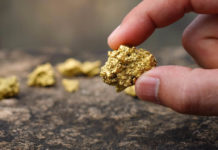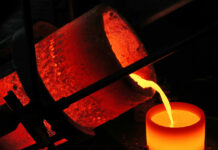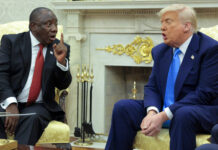
[miningmx.com] — Global miner Rio Tinto brushed off fears of a global economic crisis on Thursday, reporting record iron ore sales and a 5% jump in output for the third quarter, and forecast continued strong commodities demand.
The bullish production numbers and comments boosted shares in Rio Tinto, the world’s second-largest miner of iron ore, used for steel-making, and appeared to dampen investor concerns over the economic vulnerability of its biggest market, China.
“We are operating at full capacity, selling all we produce and our growth programme is on track, supported by the strength of our balance sheet,” Chief Executive Tom Albanese said in the company’s quarterly production report.
“Whilst we are mindful of current market volatility, the fundamentals are holding up well, particularly for bulk-traded commodities,” he said.
The materials component of MSCI’s index of Asia Pacific shares outside Japan has fallen more than 20% since late July, when global equity markets began tumbling on fears of renewed recession in the developed world.
Bank of America Merrill Lynch analyst Peter O’Connor said Rio Tinto had set production records “where it counts”, highlighting in a client note that 71% of the company’s 2011 earnings before interest, tax, depreciation and amortisation were projected to come from iron ore sales.
Rio Tinto, second to Vale of Brazil in iron ore output, maintained its 2011 forecast for record production of more than 240 million tonnes and said third-quarter output had jumped 5% to 64 million tonnes.
Rio Tinto’s Australian shares closed 2.8% higher at A$69.34, against a gain of less than 1% in the wider market. The shares are down about 21% for the year-to-date, against an 11% fall for the benchmark.
BULLISH STANCE
Rio Tinto’s bullish stance come as spot iron ore prices trade at their lowest levels since November 2010 on slower demand from China owing to weak steel prices.
But a drop in sales revenue from iron ore is unlikely to turn up until the end of the year.
During the third quarter Rio Tinto priced the majority of its iron ore using a quarterly index-linked price, set at the prior quarter’s average lagged by one month.
Signs of slowing steel demand in China have weighed on steel prices, particularly long products used for construction, due to tighter credit in China and as a construction boom that fuelled a record pace of production earlier in the year had lost steam.
Analysts were expecting production increases for both iron ore and coking coal from Rio Tinto, given that it has embarked on major expansion works in those two commodities.
Even in a declining market, Rio Tinto is seen as among the last to slow down output of steel-related raw materials due to its low production costs.
China is the key market for Rio Tinto’s iron ore business, but there have been concerns that the Chinese economy could be headed for a hard landing. Its trade surplus narrowed in September for a second straight month as growth of exports and imports both pulled back, seen as a reflection of global economic weakness and domestic cooling.
On the other hand, China imported 60.57 million tonnes of iron ore in September, the highest monthly volume since January.
BHP Billiton’s iron ore resources are also dominated by mines in Australia and it also is producing more. It ran at the higher annualised production rate of 165 million tonnes in the September quarter of this year, well above last year’s rate of 144 million tonnes.
Rio Tinto’s output of hard coking coal, another steel-making raw material, rose 14% in the third quarter from a year earlier and soared 55% from the second quarter as Rio Tinto’s flood-stricken Australian mines returned to normal.
The company was forced to downgrade guidance for mined copper by 3% and 4% for refined copper due to a 15-day work stoppage at its 30%-owned Escondida mine in Chile, exacerbated by lower ore grade.










